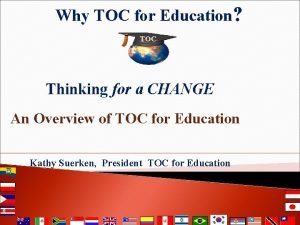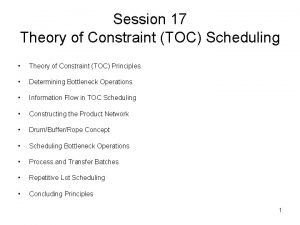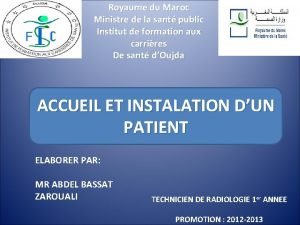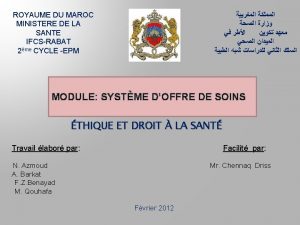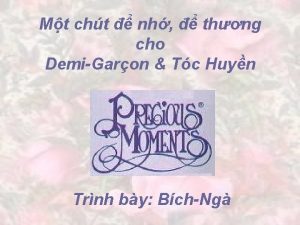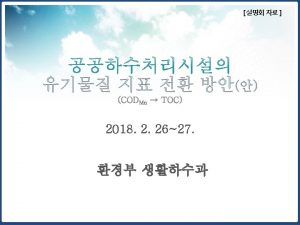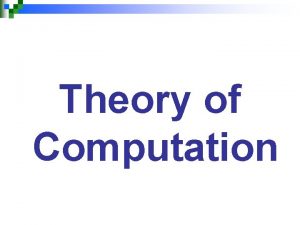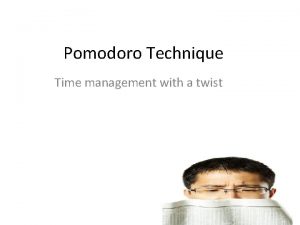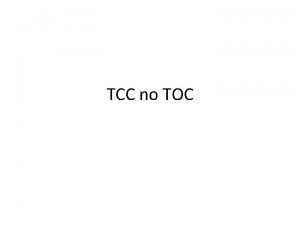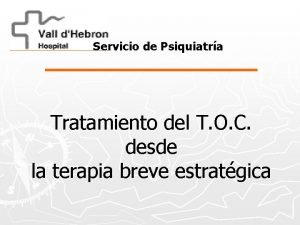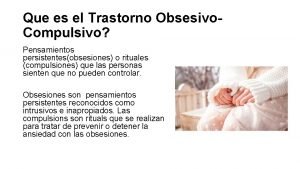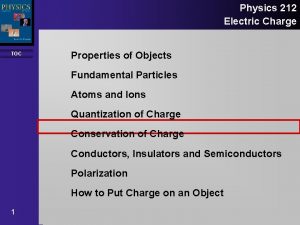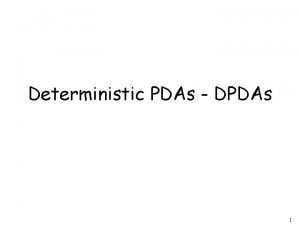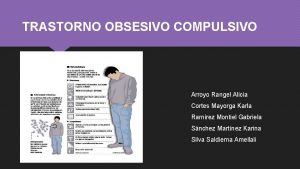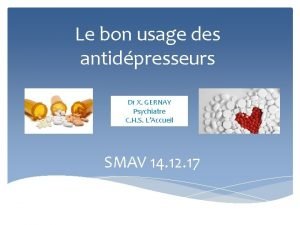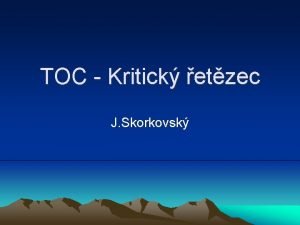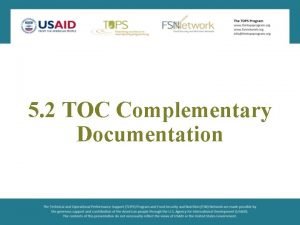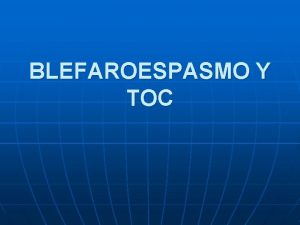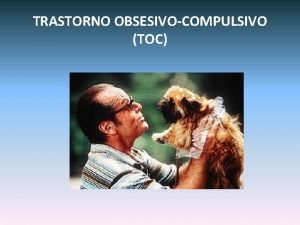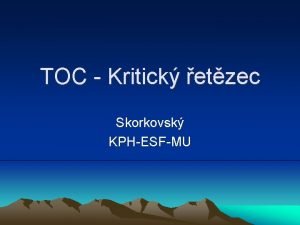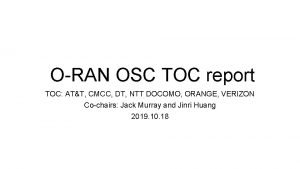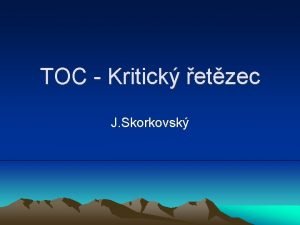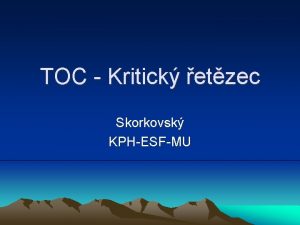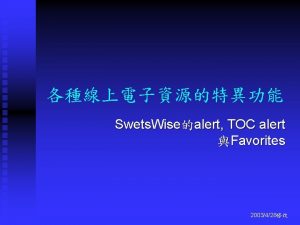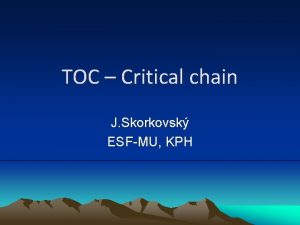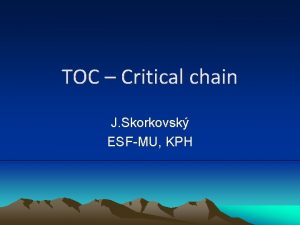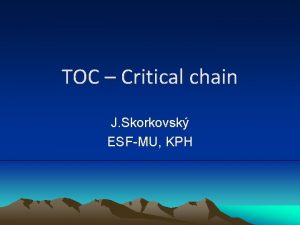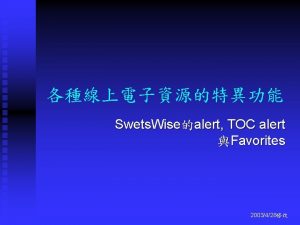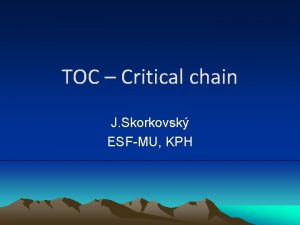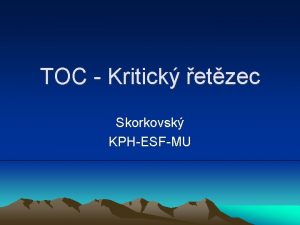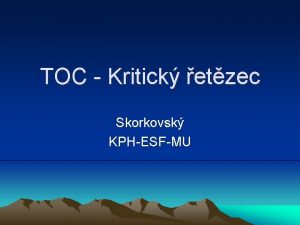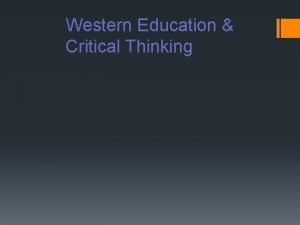Why TOC for Education TOC Thinking for a






























































- Slides: 62

Why TOC for Education? TOC Thinking for a CHANGE An Overview of TOC for Education Kathy Suerken, President TOC for Education

Why TOC for Education? What does education have to do with people…. of all ages and backgrounds? Is there a common denominator? ? ? Is there a pot of gold that all education stakeholders desire? A pot of GOAL such as…. . © TOC for Education, Inc. 2017 2

People educated to be productive, responsible and harmonious…. Now and in the future © TOC for Education, Inc. 2017 3

Why TOC for Education? . Theory of Constraints (TOC) is a methodology to logically identify and overcome key limitations that prevent a person, organization or system from achieving its goal. TOC for Education • Not for profit organization. (USA 501 c 3) • Founded 1995 by Dr. Eli Goldratt (1947 -2011), creator of TOC • To spread the logic-based thinking and communication tools and common sense methodologies of TOC to all who educate in order to leave behind a better world. © TOC for Education, Inc. 2017 4

Why TOC for Education? Since our founding in 1995, what is our bottom line? • • Over 250, 000 education stakeholders trained through TOCf. E seminars and workshops impacting…. all with whom they interact in the workplace, home and especially more than 8 million children in …. © TOC for Education, Inc. 2017 5

22 Countries on 6 continents Australia Brazi l Israel Japan Peru Philippines Taiwan Colombia Lithuania Poland Trinidad & Tobago United Kingdom Chile Malaysia Singapore Indonesia Ecuador Mexico Netherlands South Africa South Korea United States www. tocforeducation. com © TOC for Education, Inc. 2017 6

Some TOCf. E highlights from around the world United Kingdom Articles published: Child Education – a monthly publication for primary school educators Times Educational Supplement -- a weekly newspaper supplement for all educators Teaching Expertise ~ Primary Leadership Paper - the quarterly magazine of the National Association, Head Teachers Teaching Primary-- a learning resource publication Israel A media based program for thinking development launched for young children to think clearly and consider themselves as scientists who explore the ‘cause-effect’ relationships in daily situations. © TOC for Education, Inc. 2017 7

Some TOCf. E highlights from around the world Peru Over 600 Peruvian Teachers attend 12 th TOCf. E International Conference in Lima 2013 initiative, “TOCf. E Changes My School Practice, “ to train 238 teachers in the cities of Lima, Ica and Huancayo, and 1075 high school students of 3 rd, 4 th and 5 th grade in Lima receives Goldratt Foundation Grant Philippines In Quezon City (population 2. 6 million) : Elementary Level Administrators: 95% are TOCFE-TRAINED (92 out of 97 principals) Secondary Level Administrators: 94% are TOCFE-TRAINED (44 out of 47 principals) Elementary and Secondary Teachers: 2 -10 in each of 143) schools trained as TOCf. E facilitator-mentors A school-based TOCf. E initiative awarded 4 th Place in the Division Level 2012 Search for Effective and Efficient Program to © TOC for Education, Inc. 2017 Reduce Dropout Rate and Increase Performance Rate 8

Some TOCf. E highlights from around the world Mexico • Ikao International School: School-wide implementation of TOCf. E in curriculum delivery, student conduct and school governance. 2013 project in partnership with city of Leon, Mexico and La Salle school of dentistry to teach oral prevention strategies using TOCf. E tools to 600 -1000 children in each of at least ten schools. Research based results published 2015. Singapore TOCf. E Prison Project “I would like to quote some of their feedback, “This is the best thing that happened to me in prison. ” “If I had attended this course during my first sentence, I would not have come back to prison again. ” Mr. Zainul Abidin Rasheed, Senior Minister of State, Ministry of Foreign Affairs © TOC for Education, Inc. 2017 9

Some TOCf. E highlights from around the world United States “Learning the Theory of Constraints can provide the TOOLS to bridge the gap between having ‘good’ ideas and effectively making the improvements we envision. ” Dr. Suzanne Klein, Superintendent of Schools, Grosse Pointe, Michigan “We did not experience any more harassment of new students by our high school senior students in the two school years since this 30 minute intervention took place using the TOC CLOUD. ” Doug Roby, Counselor, South High School, Michigan Books Published: TOC Learning Connection The How and Why of Thinking in Schools …Never Ending Story (workbook) Stop and Think! With the Evaporating Cloud Stop and Think! Making Decisions The Skinny Book of TOC Success: An Adventure © TOC for Education, Inc. 2017 10

Some TOCf. E highlights from around the world Japan Training Workshop Tokyo August 2012 I found that my kids think more logically than I realized I will use the tools and materials to train all the company staff So useful! It’s a culture shock! Kyoto University Professor – Vice chairman of MBA program committee decided to incorporate this body of knowledge as basis of their MBA course 5 companies ordered “TOC Learning Connection” textbooks to train company staff Local communities in more than 10 cities conduct monthly study sessions © TOC for Education, Inc. 2017 11

TOCf. E Applications Curriculum delivery Counseling/ bullying School governance Dyslexia Parent groups Sports teams Juvenile Justice Peer Mediation Learning disabilities Citizen Groups Dental School Alcohol and drug counseling Children who have been abused Young children who have not yet learned to read and write © TOC for Education, Inc. 2017 12

TOCf. E Research Ph. D Dissertations Israel (2) - Philippines (2) - Poland (3) - United States (2) Master’s Theses - Philippines (3)_ - United Kingdom - Mexico - Many more underway. To view a selection of TOCf. E research presentations: www. tocforeducation. com/research. html © TOC for Education, Inc. 2017 13

Why TOC for Education? Why has TOC for Education continued to succeed… more and more? © TOC for Education, Inc. 2017 14

Why TOC for Education? The TOC methods to bring desired improvements are developed to answer three questions: What to Change? What to Change to? How to Cause the Change? © TOC for Education, Inc. 2017 15

The improvement toward which we strive…. . People educated to be productive, responsible and harmonious…. Now and in the future © TOC for Education, Inc. 2017 16

What to Change? What’s getting in the way of our goal? • Do you agree these are some common problems in education? • There are negative influences and declining family and social values • Bullying and truancy is on the rise • Many students do not know how to effectively solve problems (especially conflicts) • Many students do not take responsibility for their actions • Many students memorize instead of analyze • Many students do not know how to interpret, question and evaluate information © TOC for Education, Inc. 2017 17

What to Change…more problems • Learning is not seen as relevant to real life and many students are not able to apply what they learn • Competition and testing sometimes creates disharmony within classrooms and school systems • There are insufficient resources (especially time) available to educators to meet the learning and behavior needs of all their students • Fixing these problems requires a lot of intervention in and out of the classroom…and is very stressful © TOC for Education, Inc. 2017 18

What to Change? What do you think? Does the existence of these problems prevent many children from being productive and responsible now and in the future? Do you think these same problems exist in other countries? These problems exist worldwide! © TOC for Education, Inc. 2017 19

What to Change? Why can’t we fix these problems? Why is it that, in spite of dedicated educators and many best practices, we still have these problems? Is it because students are unable to prevent or fix these problems for themselves? Is it because educators lack the resources to do it for them? OR Is it because current best practices are not sufficiently robust? © TOC for Education, Inc. 2017 20

What to Change to? What if there were simple THINKING TOOLS that enable students at all levels to: • Analyze, rather than just memorize, information • Apply the same process of analysis and clear, critical thinking to real life-everyday-- problems • See what they learn and do as relevant to their everyday lives, thereby enhancing their motivation • Think through consequences of actions and ideas • Make reasoned judgments and decisions • Establish and create logical plans to achieve worthy goals © TOC for Education, Inc. 2017 21

What to Change to? And what if…. . These tools could be used to teach existing curriculum and responsible, ethical decision making at the same time? Would such tools enhance educators existing resources, leaving them with more time for that which they consider most important and rewarding? If such tools actually existed, should we teach them to students? © TOC for Education, Inc. 2017 22

How to Cause the Change: TOC Thinking TOOLS © TOC for Education, Inc. 2017 23

Criteria of the TOC methodology • Simple…. breaks seemingly complex problems down into simple, clear and focused analysis. Does the method focus on what’s most important and help to eliminate complicated and confusing information? • Graphically structured … provides visual framework to enhance understanding and memory • Practical…. enables the underlying theory to yield practical outcomes • Activates prior knowledge…enables learner to scaffold prior knowledge and experience to new knowledge • Socratic…provides questions that enables the learner to discover and take ownership of answers • Non exclusive…. works with all ages, abilities and cultures © TOC for Education, Inc. 2017 24

to CAUSE THE CHANGE © TOC for Education, Inc. 2017 25

How to Cause the Change The Cloud is a TOC thinking tool that analyzes the details of a conflict, meaningful action or decision in a concise and non provocative way. NEED OBJECTIVE WANT Side 1 Side 2 NEED WANT © TOC for Education, Inc. 2017 26

How to Cause the Change Written by Joel and Alex when 9 yrs old from Singapore, courtesy of Wong Siew Shan NEED OBJECTIVE Play happily together WANT Joel calls Alex names Have fun NEED To be respected Side 1 Side 2 WANT Alex doesn’t want to be called names. © TOC for Education, Inc. 2017 27

How to Cause the Change An Alternative to Hazing Doug Roby, South High School, Grosse Pointe, Michigan, USA I’m a student assistance coordinator at a large high school where we were experiencing problems with seniors who were hazing freshmen or other new students. By hazing I mean they were trying to make them do ridiculous, humiliating or even painful things. This cloud came from a group intervention I did with about 20 senior girls on hazing. I explained the concept of the cloud to the students, had them raise assumptions on only one side of the cloud and then identify solutions. Here is one example. It took about 30 minutes to get to solutions. Prepared for my future © TOC for Education, Inc. 2017 Authority/ power Haze other students Safety Don’t haze other students 28

How to Cause the Change Results? The students made assumptions between their wants and needs such as: It makes me look important; it happened to me; we are seniors and need to show our authority; it is a tradition. As they went through this process, they came up with alternative ways to meet needs: “As seniors, we already have seniority. We could introduce ourselves to the freshmen and help them find there way around the campus. We should be the people they look up to admire, not run away from. The result of this intervention? We did not experience any more hazing on our campus in the two school years since this intervention took place using the cloud. What a powerful tool to get students to really understand why they are doing something, what effect their actions have on others and to find alternative ways to meet their needs. © TOC for Education, Inc. 2017 29

How to Cause the Change The TOC tools work at all developmental levels of students, even those who do not yet have well developed literacy skills as noted in this pictorial application of the cloud by a kindergartner in Israel. © TOC for Education, Inc. 2017 30

How to Cause the Change The Cloud thinking tool can be used to analyze existing curriculum. Any meaningful action, decision or conflict in content can be analyzed using the cloud in a way that promotes the perception of relevance to the students’ daily life. An example from Oliver Twist written with six year olds at Alderman Pounder Nursery School, England courtesy of Linda Trapnell Clear conscience; not do something wrong Don’t be a pickpocket Side 1 Side 2 Survive Get money © TOC for Education, Inc. 2017 Be a pickpocket 31

The CLOUD as a way to question, interpret and evaluate content under study Solving Oliver’s Dilemma • The students were asked: In order to get money, why must Oliver be a pickpocket? • They answered: Oliver must think the only way to get money is to steal! • The students came up with other solutions: “I can do something else to earn money: clean windows, wash clothes, look after horses, or work in a shop!” Get money Be a pickpocket © TOC for Education, Inc. 2017 32

How to Cause the Change Transfer of Learning to real life problems After learning the cloud in a curriculum lesson in class, this year- one Malaysian student went home and, on his own initiative, applied the tool to a conflict he was having with a sibling. Example courtesy of Khaw Choon Ean © TOC for Education, Inc. 2017 33

© TOC for Education, Inc. 2017 34

How to Cause the Change? The Logic Branch provides a framework for analysis Let’s consider two types of frameworks Consider each fact separately and independent of the others Use cause and effect logic to find relationships between the facts so that you can remember them more easily © TOC for Education, Inc. 2017 35

How to Cause the Change The Logic Branch to analyze a science lesson Written by 5 th grade class in Israel Example courtesy of David Vezler The water pollutes the environment The quality of human life is damaged The water causes diseases and death The filthy water harms the animals and the plants Filthy water flows on the ground surface People become sick and their health is damaged The filthy water spreads bad smell Filthy water contains harmful components, microbes and pollution The filthy water harms the animals and the plants People drink the under ground water Some of the filthy water trickles in the ground © TOC for Education, Inc. 2017 36

Analysis of history lesson by 8 th grade student in Maryland, USA , courtesy of Manfred Smith © TOC for Education, Inc. 2017 37

The TOC learning processes differentiate instruction: In World Studies, the TOC process has helped the students put an immense amount of facts and information into a logical and systematic order. From this, they are able to extract and apply information to writing prompts, group discussions, and expand their answers beyond basic recall. This is phenomenal because many of the students being served in this class were once self-contained special needs students who are reading at or near a third or fourth grade reading level. The TOC process has given them the ability to clearly understand how facts and information relate to other areas in history and it is has pushed them to another area of higher-order thinking. Jennifer G. Harris 8 th grade Inclusion Teacher for World Studies Takoma Park Middle School © TOC for Education, Inc. 2017 38

How to Cause the Change Logic Branch, using pictures, written by Polish pre-K students working with Dorota Kaminska, Mazovian In-Service Teacher Training Centre, to logically retell story of Little Red Riding Hood © TOC for Education, Inc. 2017 39

Application of the LOGIC BRANCH to behavior Rather than tell me what to do and what not to do, lead me to discover the consequences of my actions/ideas. The branch is used to understand cause-effect links between actions and consequences, make predictions, and create new and better solutions. © TOC for Education, Inc. 2017 40

How to Cause the Change Belinda Small, teacher, Florida, USA “A 7 th grade student had been making noises in another teacher’s class. She asked me to help. I used the TOC process to enable this student to think for himself the cause/effect results of his actions. Although I did the initial writing of his words, at one point I had to leave and attend to my own class (obvious in the graphic). Nevertheless, this normally very disruptive student picked up the pencil — and responsibility — and continued in his own words/graphics. ” © TOC for Education, Inc. 2017 41

RESULTS Furious Fail class Although he had been sent to the principal’s office 40 times in the previous 6 weeks by this teacher, after this experience with TOC, he completed the year (next 6 months) without a repeat offense with this teacher. I get an F Don’t do assignment Teacher gets mad Another student gets mad © TOC for Education, Inc. 2017 Don’t listen I get mad I make noises in class 42

A Logic Branch on the positive outcomes of doing Homework Work of Marcia Hutchinson with students at Stevenson Middle School Los Angeles California © TOC for Education, Inc. 2017 43

How to Cause the Change Logic Branch as hopscotch game on playground Primary School, Perak, Malaysia EAT MEDICINE TO HOSPITAL FALL DOWN TABLE’S LEGS BREAK LIKES TO CLIMB TABLE Example courtesy of Khaw Choon Ean

How to Cause the Change © TOC for Education, Inc. 2017 45

How to Cause the Change • Used by teachers and students to achieve mutual goals • Used by students to analyze curriculum • Used by students to achieve personal goals • Used by educational staff to achieve management goals AMBITIOUS TARGET OBSTACLES OBJECTIVES PLAN © TOC for Education, Inc. 2017 46

How to Cause the Change Target: The Ambitious Target Tree Raise Reading Test Scores OBSTACLES OBJECTIVES PLAN 1. The test is too long. Make it shorter. 1. Use a pencil to divide passages into smaller parts. 2. I get stuck and can’t Have reminders in remember the 1 st the margins. paragraph. 2. Summarize after each section/under-line. 3. All the answers look Know the same. differences between choices. 3. Underline key differences in possible choices. Part of a strategic plan written by 7 th grade English class of Belinda Small, USA © TOC for Education, Inc. 2017 47

How is this different? According to the teacher, Belinda Small, Florida, USA: • The STUDENTS think of the solutions. • The STUDENTS create the language. • The STUDENTS use THEIR logic. • The STUDENTS form the connections between the State Academic Standards. • The STUDENTS make the connections between the State Academic Standards and the State Standardized test questions. • Best of all: THEY USED IT ! © TOC for Education, Inc. 2017 48

Case study: Maria E Villarreal Primary School, Escobedo, Mexico “At our school we used TOC tools with very problematic groups of students to change their attitudes. In one case, we worked with a group on the Ambitious Target of being the best students. When the students wrote their obstacles, they blamed others, but when they thought of ways to overcome their obstacles they took the responsibility for the solution. ” © TOC for Education, Inc. 2017 49

How to Cause the Change Be the best students OBSTACLES OBJECTIVES Grumpy teachers We listen to teachers Lazy students We are prepared for class We don’t study We study continually Missed classes We attend school regularly We talk in class We listen to our teachers We bother classmates We respect each other in class We get to class late We are on time for class We do not participate We gladly participate © TOC for Education, Inc. 2017 50

How to Cause the Change Results? The teacher reports that the group has changed. “The students are learning to value themselves. The group was very much in conflict, but now I can see they are growing up because they are using the TOC tools to think through their problems. ” © TOC for Education, Inc. 2017 51

The Ambitious Target tool to analyze curriculum Target: A prosperous civilization in the land between the rivers. OBSTACLES OBJECTIVES PLAN 1. The river floods and there is no way to know when. 1. We are protected against unexpected floods. 1. We irrigate the fields by building network of canals and dikes. 2. There can be summer droughts. 2. We have enough water and food. 2. We get water from the river. We keep extra supply of food. 3. We don’t have all the resources needed for a wealthy civilization. 3. We have access to the 3. We trade with other resources we need to have a communities. prosperous civilization. 4. Neighboring people are not friendly. 4. We protect our security. 4. We establish an army. We build strongholds. © TOC for Education, Inc. 2017 52

How to Cause the Change A set of THINKING TOOLS that enable students at all levels to: • Effectively analyze, rather than memorize, information • Apply the same process of analysis and clear thinking to real life problems • See what they learn and do as relevant to their everyday lives, thereby enhancing their motivation • Think through consequences of actions and ideas • Make reasoned judgments and decisions • Set and create logical plans to achieve goals © TOC for Education, Inc. 2017 53

Tools that educate people to become responsible and productive now and in the future. Productive and Responsible People © TOC for Education, Inc. 2017 54

Why TOC for Education? Do the TOC thinking/learning processes work with everyone? “ TOC is simple enough to be used by kindergarteners… Alderman Pounder Infant and Nursery School, United Kingdom Example courtesy of Linda Trapnell © TOC for Education, Inc. 2017 55

Why TOC for Education? “ TOC is simple enough to be used by kindergarteners and profound enough to be used with CEO’s” Denise Meyer, former Assistant Principal, Los Angeles Unified School District And… even those with a tougher set of obstacles… © TOC for Education, Inc. 2017 56

Taking responsibility for achieving Ambitious Targets …. . a case study from Kathy Suerken When listening to a group of 15 -18 year old juvenile offenders explain how they ended up in jail, I noted that their explanations were written in the language of blame. Because nobody likes to feel they are a bad person, it is common practice for us to justify our actions by deflecting the blame elsewhere. Therefore, we allow ourselves to think we are just responding to someone else’s mistake/ bad behavior. But what about taking responsibility for changing our reality to include our ‘mode of operation’? I worked with three groups that day using the Ambitious Target tool—never more than 60 minutes per group. The following example was typical for each group as the TOC tool enabled THEM to hold themselves accountable… WITH DIGNITY. © TOC for Education, Inc. 2017 57

Taking responsibility for achieving Ambitious Targets Ambitious Target GOOD LIFE OBSTACLE INTERMEDIATE OBJECTIVE 1. Jealous people 2. Prejudiced people. 3. Criticism. 4. My past. 5. Ignorance. 6. MYSELF 7. Lack of self esteem. 8. Lack of confidence. Class of Juvenile Offenders, Juvenile Detention Camp, California, USA © TOC for Education, Inc. 2017 58

Taking responsibility for achieving Ambitious Targets Ambitious Target GOOD LIFE OBSTACLE INTERMEDIATE OBJECTIVE 1. Jealous people 2. Prejudiced people. 3. Criticism. 4. My past. 5. Ignorance. 6. MYSELF 6. I have to change myself. 7. Lack of self esteem. 8. Lack of confidence. Class of Juvenile Offenders, Juvenile Detention Camp, California, USA © TOC for Education, Inc. 2017 59

Taking responsibility for achieving Ambitious Targets Ambitious Target GOOD LIFE OBSTACLE INTERMEDIATE OBJECTIVE 1. Jealous people 1 a. Ignore them. 1 b. Focus on your goal. 2. Prejudiced people. 2. Same as #1. 3. Criticism. 3. Same as #1. 4. My past. 4. Don’t make the same mistakes. 5. Ignorance. 5. Stop hanging around with gangs 6. MYSELF 6. I have to change myself. 7. Lack of self esteem. 7. Have faith in yourself. 8. Lack of confidence. 8. Courage. Class of Juvenile Offenders, Juvenile Detention Camp, California, USA © TOC for Education, Inc. 2009 © TOC for Education, Inc. 2017 All rights reserved 60

Why TOC for Education? . Written by a Juvenile Offender at a Juvenile Detention Center in California © TOC for Education, Inc. 2017 61

Why TOC for Education? . Written by a Juvenile Offender at a Juvenile Detention Center in California 62 © TOC for Education, Inc. 2017
 Entrez donc saint nicolas
Entrez donc saint nicolas Chant jeunesse adventiste
Chant jeunesse adventiste Why why why why
Why why why why Toc meaning school
Toc meaning school Dont ask
Dont ask Positive thinking vs negative thinking examples
Positive thinking vs negative thinking examples Thinking about your own thinking
Thinking about your own thinking Analytic vs holistic thinking example
Analytic vs holistic thinking example Perbedaan critical thinking dan creative thinking
Perbedaan critical thinking dan creative thinking Thinking about you thinking about me
Thinking about you thinking about me Toc in pharmaceutical industry
Toc in pharmaceutical industry Toc mérés
Toc mérés Toc scheduling
Toc scheduling Toc doc maroc
Toc doc maroc Toc doc maroc
Toc doc maroc Vận tốc góc
Vận tốc góc Analizator toc
Analizator toc Vua nào thần tốc quân hành mùa xuân
Vua nào thần tốc quân hành mùa xuân Codtoc
Codtoc Tóc demi garcon là gì
Tóc demi garcon là gì Codcr codmn
Codcr codmn Tic toc yolanda crespo
Tic toc yolanda crespo Transition graph in theory of computation
Transition graph in theory of computation Tp analyzer
Tp analyzer Paper toc
Paper toc Kieran lamb
Kieran lamb Tic toc technique
Tic toc technique Toc pump module
Toc pump module Toc sintomas graves
Toc sintomas graves Sistema perceptivo reactivo
Sistema perceptivo reactivo Toc
Toc Toc properties
Toc properties A dpda is a pda in which
A dpda is a pda in which Chủng tộc
Chủng tộc Toc homosexual
Toc homosexual Lerivon effets secondaires
Lerivon effets secondaires Why is critical reading an active process of discovery
Why is critical reading an active process of discovery When you say things without thinking
When you say things without thinking Iso 22301 utbildning
Iso 22301 utbildning Typiska novell drag
Typiska novell drag Tack för att ni lyssnade bild
Tack för att ni lyssnade bild Vad står k.r.å.k.a.n för
Vad står k.r.å.k.a.n för Varför kallas perioden 1918-1939 för mellankrigstiden?
Varför kallas perioden 1918-1939 för mellankrigstiden? En lathund för arbete med kontinuitetshantering
En lathund för arbete med kontinuitetshantering Kassaregister ideell förening
Kassaregister ideell förening Tidbok yrkesförare
Tidbok yrkesförare A gastrica
A gastrica Förklara densitet för barn
Förklara densitet för barn Datorkunskap för nybörjare
Datorkunskap för nybörjare Boverket ka
Boverket ka Debatt artikel mall
Debatt artikel mall För och nackdelar med firo
För och nackdelar med firo Nyckelkompetenser för livslångt lärande
Nyckelkompetenser för livslångt lärande Påbyggnader för flakfordon
Påbyggnader för flakfordon Lufttryck formel
Lufttryck formel Svenskt ramverk för digital samverkan
Svenskt ramverk för digital samverkan Urban torhamn
Urban torhamn Presentera för publik crossboss
Presentera för publik crossboss Teckenspråk minoritetsspråk argument
Teckenspråk minoritetsspråk argument Vem räknas som jude
Vem räknas som jude Treserva lathund
Treserva lathund Fimbrietratt
Fimbrietratt Bästa kameran för astrofoto
Bästa kameran för astrofoto



